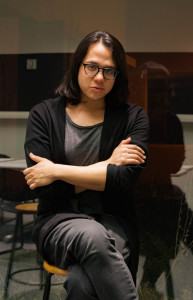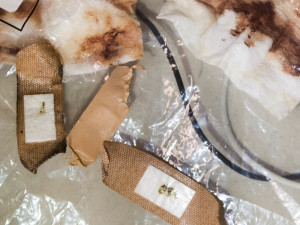Tags
Related Posts
Share This
Barela’s Band-Aids

Senior Photography Major Ysidro Barela. Photo by Whitney Wernick
Ysidro Barela recently posted on the Santa Fe University of Art and Design Student Life Facebook page. What was he looking for? Used Band-Aids. Donors were asked to save their bandages in plastic bags and assured that proper safety precautions would be taken while handling them. “Yes, I know it’s gross,” Barela says in the post. “Any kind of bandage is appreciated!”
Although it may seem bizarre to ask for other people’s used Band-Aids, Barela has been collecting them for the past three years while working on his BFA thesis project in photography.
Barela has been fascinated by photography since he was a child.
“My mom double exposed a roll of film,” he recalls. “She threw it away because it was garbage in her eyes, but I remember going through the trash can and pulling it out. I thought it was really dreamy and it just took me into a different place.”
He started working with Band-Aids at the end of 2012, when he took a two-year hiatus from school and was going through a rough patch in his life. He began looking at bandages as a metaphor for the healing process.
“We put a Band-Aid on a wound even if we don’t need it sometimes, but they’re like a comforting hug,” he says. “We leave a piece of ourselves on them and then we throw them away.”
He admits that, initially, it was a little awkward to ask strangers for their used Band-Aids, but he was able to overcome that by posting ads on Craig’slist. Eventually, he branched out to the SFUAD Student Life page and even began asking his friends and family for their used bandages with calls for them on his personal Facebook page. With some responses more positive than others, Barela understands why certain people are grossed out by his request.
Currently, Barela has approximately 30 used bandages in his custody ranging from small paper-cut sized Band-Aids to large pieces of gauze that have been used to heal larger lacerations. While working with smaller bandages, Barela will often leave them out so the adhesive will dry as this makes them much easier to handle.
“I usually use gloves,” he says, smiling. “I keep them in 4-by-5 negative holder sleeves, which is essentially meant for 4-by-5 [photography] film, so I can scan them straight from the sleeve.”
In addition to scanning the bandages, he also takes pictures of them in the studio with a camera. Drying out the adhesive is especially helpful in this case because it prevents the bandages from sticking to the gloves while he places them for pictures.
Barela hopes his Band-Aid project will provide a new perspective on what healing is in relation to the human condition.
“I just like to change people’s point of view when it comes to turning something so grotesque into something so beautiful,” he says. “I really like the idea of healing through art. When they view my work, I would like people to feel a sense of comfort and at-homeness through objects that are unconventional, like a bloody Band-Aid.”

Bandage selection. Photo by Whitney Wernick.
In the future, Barela plans to continue working with Band-Aids. He wants to display them in different ways and feature them in an autobiographical piece on the horizon.
“I’ve been using them for a long time. It’s kinda hard to stop at this point since I have so many.”
Barela’s senior thesis will be on display in the Marian Center for the Photographic Arts starting April 29.






 Jackalope Magazine is the student magazine of Santa Fe University of Art and Design. Building on the interdisciplinary nature of our education, we aim to showcase the talent of our university and character of our city.
Jackalope Magazine is the student magazine of Santa Fe University of Art and Design. Building on the interdisciplinary nature of our education, we aim to showcase the talent of our university and character of our city.
Omg Sid! Congrats. Cool pic too!